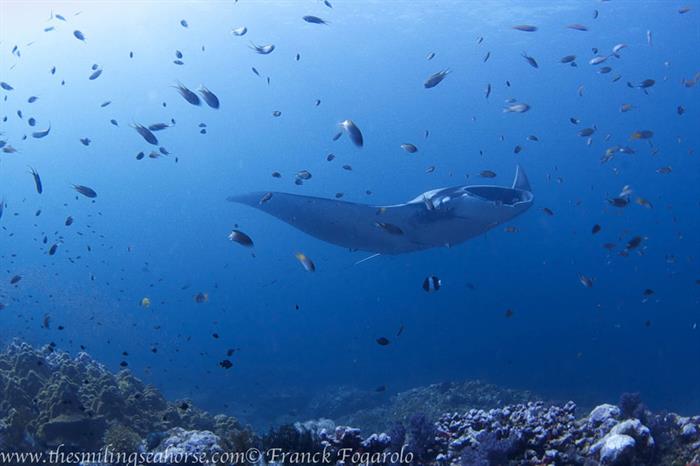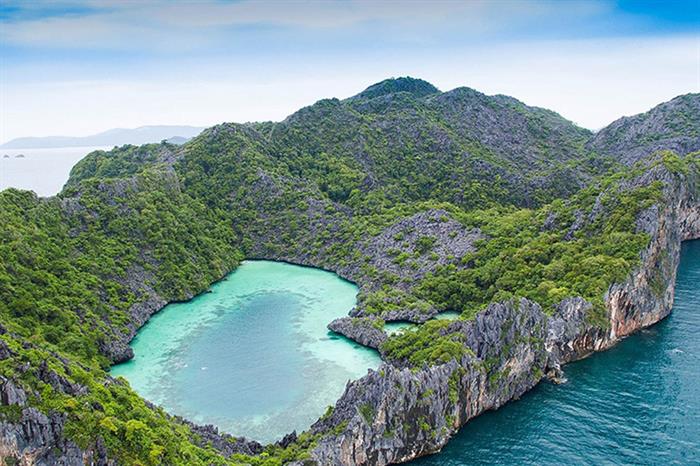News
Diving Myanmar

Myanmar was closed to tourists until recent years and many new dive sites are still being discovered. With over 50 dive sites to choose from so far, this country has plenty to offer. Highlights include exploring the 800 or so islands that make up the Mergui archipelago and the remote ocean dives at Burma Banks.
Myanmar, or Burma, opened to tourists in the late 1990s and passed the one million tourist mark for the first time in 2012. Tourism is still in its infancy in this fascinating country and so offers pristine diving in southeast Asia. Whilst Myanmar is known for its large pelagic species, it is also fast gaining a reputation for macro life.
The dive sites are remote and best experienced by Myanmar liveaboard diving. The liveaboard diving season is October to May, with peak conditions in the popular Mergui Archipelago during December to April. Water temperature typically ranges from 30°C (86 °F) to 26°C (79 °F) and visibility can reach more than 40 meters. The diving can be challenging, with strong currents and rough seas, making Myanmar suitable for more advanced divers. Most dive cruises visiting Myanmar depart from Phuket, Ranong, or Khao Lak in Thailand. The MV Thai Sea liveaboard (pictured) offers diving safaris to Myanmar, including within the Mergui Archipelago and south Myanmar.
Mergui Archipelago
The Mergui Archipelago, in the Andaman Sea, is made up of over 800 islands and is a well-known dive area of Myanmar. Only two of the islands are inhabited and the majority of the islands remain untouched by human influence. The limestone and granite rocks of the archipelago have created underwater ledges, caves, swim-throughs, and overhangs, and the marine life is very diverse. Whale sharks and manta rays are occasionally seen in this area.
 Black Rock, an 80-meter-wide islet, has steep banks, walls and fantastic drift diving. This pinnacle has a high density of marine life including numerous soft corals, beds of anemones, hawkfish, pufferfish, angelfish, banded sea snakes, and eels. This dive site receives plenty of nutrients from the depths and attracts huge schools of mobula rays, whitetip reef sharks, silvertip sharks, and blacktip sharks. Manta and eagle rays are also seen at this dive site, as are kingfish and barracuda. Black Rock is one of the most spectacular dive sites in the Mergui Archipelago.
Black Rock, an 80-meter-wide islet, has steep banks, walls and fantastic drift diving. This pinnacle has a high density of marine life including numerous soft corals, beds of anemones, hawkfish, pufferfish, angelfish, banded sea snakes, and eels. This dive site receives plenty of nutrients from the depths and attracts huge schools of mobula rays, whitetip reef sharks, silvertip sharks, and blacktip sharks. Manta and eagle rays are also seen at this dive site, as are kingfish and barracuda. Black Rock is one of the most spectacular dive sites in the Mergui Archipelago.
High Rock is another highlight and has wall diving, steep drop offs, and a rocky reef at dive depths of 5 to 25 meters. The rocks are covered with orange and green cup corals and the site is excellent for night diving, when the cup corals open to reveal their bright orange interiors. There is a huge volume of fish life at High Rock including glassfish, fusiliers and Titan triggerfish. There are numerous invertebrates, including frogfish, seahorses and scorpionfish, and the landscape below 21 meters is dominated by black-coral bushes, feather stars and gorgonians.
Rocky Peaks, or Fan Forest Pinnacle, is a pinnacle that starts at 5 meters and disappears into the depths. It is known as one of the most colourful dive sites in the archipelago and is covered in orange fan corals and Gorgonian sea fans, mostly below 30 meters. The top of the pinnacle is home to a garden of anemones, with cowries, pipefish and seahorses. The shallow parts of the area are also home to octopi and cuttlefish. Those wishing to see zebra sharks should head to the eastern edge of the ridge. Manta and eagle rays are sometimes seen at this dive site.
Shark Cave is a dive site at a chain of three islands, the Three Stooges. This cavern sits at 5 meters depth on the north west corner of one of the islands and drops down to 16 meters. The cavern gradually narrows to a tunnel about 20 meters long and emerges at the east side of the island. It is known for its resident nurse sharks and is also popular with grey reef and whitetip reef sharks. The cavern ceiling is covered in marigold cup corals and the floor is covered in sponges. Nudibranchs are commonly found there, as are moray eels, lobsters and Durban dancing shrimps. Divers can also see grey bamboo sharks in the wall cracks. The site is a Myanmar dive highlight whether explored during the day or at night.
Burma Banks
 Lying west of the Mergui Archipelago, Burma Banks is rarely visited, and it is possible to dive the area with no other divers present. The underwater landscapes are unique, with huge flat-top sea mounts at the surface disappearing to depths of over 300 meters. The underwater environments of Burma Banks are not found elsewhere. Most dives start at 15 meters and dive highlights include huge table corals, black corals, abundant reef fish, octopi, moray eels, barracuda, and many species of shark.
Lying west of the Mergui Archipelago, Burma Banks is rarely visited, and it is possible to dive the area with no other divers present. The underwater landscapes are unique, with huge flat-top sea mounts at the surface disappearing to depths of over 300 meters. The underwater environments of Burma Banks are not found elsewhere. Most dives start at 15 meters and dive highlights include huge table corals, black corals, abundant reef fish, octopi, moray eels, barracuda, and many species of shark.
The dives are open ocean and so the area attracts large pelagic species. The currents can be strong, and divers should expect advanced drift diving in this area.
 Discover more liveaboard diving holiday solutions around the world at Liveaboard.com.
Discover more liveaboard diving holiday solutions around the world at Liveaboard.com.
Gear News
Introducing the TR-80, IR-50 and CS-30 Regulators from DYNAMICNORD

Whether you are a beginner or a professional diver – with the three new main regulators from DYNAMICNORD, everyone will find their favourite regulator. They all look super stylish.
Excellent performance with the TR-80
Quality and performance are the be-all and end-all for regulators. It is not for nothing that the TR stands for Tec Reg. The innovative design of the TR-80 guarantees absolute reliability – even in ice-cold waters.

Perfect breathing effort at 0.8 J/l / certified for diving in waters below 10 degrees / structural design made of solid brass for best cold protection / membrane-compensated design with dry seal of the first stage / reduced exhalation effort thanks to optimized exhalation membrane and bubble deflector / adjustable Venturi (dive/predive) and adjustment knob for individual inhalation comfort / innovative design of the front cover prevents free-flow in strong currents or when diving with scooters / design made of sandblasted brass, matt chrome finish / 2 HP and 4 LP outlets / mouthpiece made of high-quality, anti-allergic silicone for maximum comfort.


Amazing underwater adventures with the IR-50
The IR-50 is the top regulator for advanced and experienced divers. Natural breathing is the essence of this regulator.

Ideal breathing effort at 0.8 J/l /certified for diving in waters below 10 degrees / compensated membrane / adjustable venturi (dive/predive) and adjustment knob for individual inhalation comfort/ outlet valve and deflector for minimum exhalation effort and reduction of bubbles on the face / design made of sandblasted brass, matt chrome finish / 2 HP and 4 NP outlets / mouthpiece made of high-quality, anti-allergic silicone for maximum comfort.


The Workhorse – our CS-30
For diving centres and diving beginners – the workhorse stands for strong construction, reliability and robustness. Perfect for your training.

Optimal breathing effort at 0.8 J/l /recommended for diving in waters above 10 degrees / non-compensated piston / adjustable venturi (dive/predive) / outlet valve and deflector for minimum exhalation effort and reduction of bubbles on the face / design made of sandblasted brass, matt chrome finish / 1 HP and 3 NP outlets / mouthpiece made of high-quality, anti-allergic silicone for maximum comfort.


Octopus OP-30
The OP-30 is the ideal addition to all DYNAMICNORD regulators. It is identical in construction to the CS-30.

The TR-80, IR-50, CS-30 (DIN & INT) regulators and the Octopus OP-30 are available from DYNAMICNORD dealers and in the online store.
DYNAMICNORD – Your Outdoor Companion.
Marine Life & Conservation
Paul Watson Released as Denmark Blocks Japan’s Extradition Bid

Renowned anti-whaling activist Paul Watson has been released from custody in Greenland after spending five months in detention. Denmark’s Justice Ministry rejected Japan’s request for his extradition, citing insufficient guarantees that his time already served in custody would be credited against any potential sentence.
The 74-year-old Canadian-American was arrested on July 21 in Nuuk, Greenland’s capital, when his ship docked to refuel. His arrest was based on a 2012 Japanese warrant related to a 2010 encounter in Antarctic waters. Japan alleged Watson obstructed operations and caused damage to a whaling research ship during efforts to disrupt illegal whaling. Watson has consistently denied these claims, maintaining his commitment to marine conservation.
Denmark, which oversees extradition matters for Greenland, concluded that while the legal conditions for extradition were met, the lack of assurances from Japan regarding time-served credit made extradition untenable.
In a video shared by his foundation, Watson expressed gratitude and relief, saying, “After five months, it’s good to be out… and good to know they’re not sending me to Japan.” He added that the most difficult part of his time in custody was being separated from his two young sons.
Watson is a pioneering figure in marine conservation, known for founding the Captain Paul Watson Foundation in 2022 after decades of activism with the Sea Shepherd Conservation Society. His bold efforts to defend marine life have earned him widespread support, including from celebrities and conservationists. His work has also been featured in the acclaimed reality TV series Whale Wars.
Watson’s lawyer, Jonas Christoffersen, praised the decision, stating, “We are happy and relieved that Paul Watson is now free.” He added that Watson is eager to reunite with his family and continue his vital work.
The arrest occurred while Watson’s vessel, the M/Y John Paul DeJoria, was en route to the North Pacific with a team of 26 volunteers to intercept a Japanese whaling ship. His foundation described the arrest as politically motivated and emphasized that Watson’s actions were focused on ending illegal whaling practices.
Japan resumed commercial whaling in 2019 after leaving the International Whaling Commission, asserting that whale meat is a cultural tradition. Conservationists, however, continue to challenge these practices, highlighting their impact on marine ecosystems.
Despite the challenges, Watson remains steadfast in his mission to protect marine life and bring attention to whaling practices. His dedication to ocean conservation has made him a globally respected advocate for the environment.
-

 News2 months ago
News2 months agoIconic SS United States to become the World’s Largest Artificial Reef
-

 News3 months ago
News3 months agoBook Review – 52 Assignments: Underwater Photography
-

 Gear News3 months ago
Gear News3 months agoDYNAMICNORD – New German diving brand enters the British market
-

 News3 months ago
News3 months agoExploring Cenote El Pit: A Diver’s Dream
-

 Gear News3 months ago
Gear News3 months agoTry BARE drysuits (and maybe even win one!) this Friday with Sea & Sea at North West Dive Fest
-

 Marine Life & Conservation3 months ago
Marine Life & Conservation3 months agoBook Review: Coral Triangle Cameos
-

 Blogs2 months ago
Blogs2 months agoDive the Egyptian Red Sea this Autumn with Regaldive
-

 News3 months ago
News3 months ago2024 Ocean Art Underwater Photo Competition Announced
















